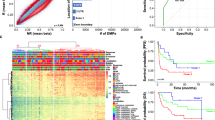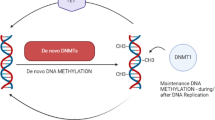Abstract
Objectives
The study aimed to evaluate the methylation pattern of the interferon-gamma (IFN-γ) gene in oral cancer tissues compared with normal and benign oral disease tissues.
Materials and methods
The oral tissues were gained from the patients of 85 cases of oral squamous cell carcinoma (OSCC), 47 cases of oral dysplastic lesions, and 53 normal biopsies. IFN -γ methylation in oral tissues was verified through methylation-specific polymerase chain reaction (PCR) and DNA sequencing analyses, and the expression levels of IFN-γ messenger RNA (mRNA) and protein were detected using real-time reverse transcription (RT)-PCR and enzyme-linked immunosorbent assays, respectively. IFN-γ was localized in macrophages from oral tissues and detected via immunostaining.
Results
IFN-γ mRNA and protein expression levels were evidently decreased in oral cancer tissues, whereas the IFN-γ methylation rate was significantly higher in malignant tumors than in benign and normal tissues (normal, 22.6%; benign, 38.3%; and cancer, 55.3%; P < 0.05). Furthermore, the expression of IFN-γ mRNA was significantly downregulated in oral tumors with methylation compared with tumors without methylation, as determined by real-time RT-PCR (4.76-fold difference; P < 0.05). Likewise, mRNA expression was downregulated by 6.79-fold in oral epithelial dysplasia tissues with methylation compared with those without methylation (P < 0.01). Co-immunostaining to detect MAC2 and IFN-γ demonstrated that macrophages comprised the main source of IFN-γ in oral tissues. IFN-γ methylation demonstrated a significant association with the clinical stage, histopathology grade, and primary tumor.
Conclusions
Aberrant IFN-γ promoter methylation may be involved in the process of tumorigenesis of oral cancer.
Clinical relevance
IFN-γ hypermethylation during the process of oral carcinogenesis could be useful for the clinical diagnosis and treatment for OSCC.




Similar content being viewed by others
References
Brocklehurst P, Kujan O, O’Malley LA et al (2013) Screening programmes for the early detection and prevention of oral cancer. Cochrane Database Syst Rev 11:CD004150
Schmidt BL, Kuczynski J, Bhattacharya A et al (2014) Changes in abundance of oral microbiota associated with oral cancer. PLoS One 9:e98741
Bagan JV, Scully C (2008) Recent advances in oral oncology 2007: epidemiology, aetiopathogenesis, diagnosis and prognostication. Oral Oncol 44:103–108
Lin WW, Karin M (2007) A cytokine-mediated link between innate immunity, inflammation, and cancer. J Clin Invest 117:1175–1183
Smyth MJ, Cretney E, Kershaw MH et al (2004) Cytokines in cancer immunity and immunotherapy. Immunological Rev 202:275–293
Lin EY, Pollard JW (2004) Role of infiltrated leucocytes in tumor growth and spread. Br J Cancer 90:2053–2058
Venetsanakos E, Beckman I, Bradley J et al (1997) High incidence of interleukin 10 mRNA but not interleukin 2 mRNA detected in human breast tumours. Br J Cancer 75:1826–1830
Mocellin S, Wang E, Marincola FM (2001) Cytokines and immune response in the tumor microenvironment. J Immunother 24:392–407
Schoenborn JR, Wilson CB (2007) Regulation of interferon-gamma during innate and adaptive immune responses. Adv Immunol 96:41–101
Sugerman PB, Savage NW, Walsh LJ et al (2002) The pathogenesis of oral lichen planus. Crit Rev Oral Biol Med 13:350–365
Smith NL, Denning DW (2014) Clinical implications of interferon-γ genetic and epigenetic variants. Immunology 143:499–511
Viana MB, Cardoso FP, Diniz MG et al (2011) Methylation pattern of IFN-γ and IL-10 genes in periodontal tissues. Immunobiology 216:936–941
Cho YH, Shen J, Gammon MD et al (2012) Prognostic significance of gene-specific promoter hypermethylation in breast cancer patients. Breast Cancer Res Treat 131:197–205
Ma D, Jiang C, Hu X et al (2014) Methylation patterns of the IFN-γ gene in cervical cancer tissues. Sci Rep 4:6331–6331
Lovinsky-Desir S, Ridder R, Torrone D et al (2014) DNA methylation of the allergy regulatory gene interferon gamma varies by age, sex, and tissue type in asthmatics. Clin Epigenetics 6:9
Goldenberg D, Harden S, Masayesva BG et al (2004) Intraoperative molecular margin analysis in head and neck cancer. Arch Otolaryngol Head Neck Surg 130:39–44
Sanders VM (2006) Epigenetic regulation of Th1 and Th2 cell development. Brain Behav Immun 20:317–324
Esteller M (2005) Aberrant DNA methylation as a cancer-inducing mechanism. Annu Rev Pharmacol Toxicol 45:629–656
Kerr KM, Galler JS, Hagen JA et al (2007) The role of DNA methylation in the development and progression of lung adenocarcinoma. Dis Markers 23:5–30
Grivennikov SI, Greten FR, Karin M (2010) Immunity, inflammation, and cancer. Cell 140:883–899
Mantovani A, Allavena P (2015) The interaction of anticancer therapies with tumor-associated macrophages. J Exp Med 212:435–445
Author information
Authors and Affiliations
Corresponding authors
Ethics declarations
Conflict of interest
The authors declare that they have no competing interests.
Funding
This work was supported by grants from the National Nature Science Foundation of China (No. 81541149) and the Tianjin health and Tianjin Health and Family Planning Commission of Science and Technology Project Foundation (No. 16KG153).
Ethical approval
All procedures performed in studies involving human participants were in accordance with the ethical standards of the institutional research committee of the Second Hospital of Hebei Medical University, Shijiazhuang, Hebei Province, China, and with the 1964 Helsinki Declaration and its later amendments or comparable ethical standards.
Informed consent
Informed consent was obtained from all individual participants included in the study.
Additional information
Songbo Tian, B.D., Chunyang Jiang, Xiaoqin Liu, and Sheng Xu contributed equally to this work.
Rights and permissions
About this article
Cite this article
Tian, S., Jiang, C., Liu, X. et al. Hypermethylation of IFN-γ in oral cancer tissues. Clin Oral Invest 21, 2535–2542 (2017). https://doi.org/10.1007/s00784-017-2052-z
Received:
Accepted:
Published:
Issue Date:
DOI: https://doi.org/10.1007/s00784-017-2052-z




